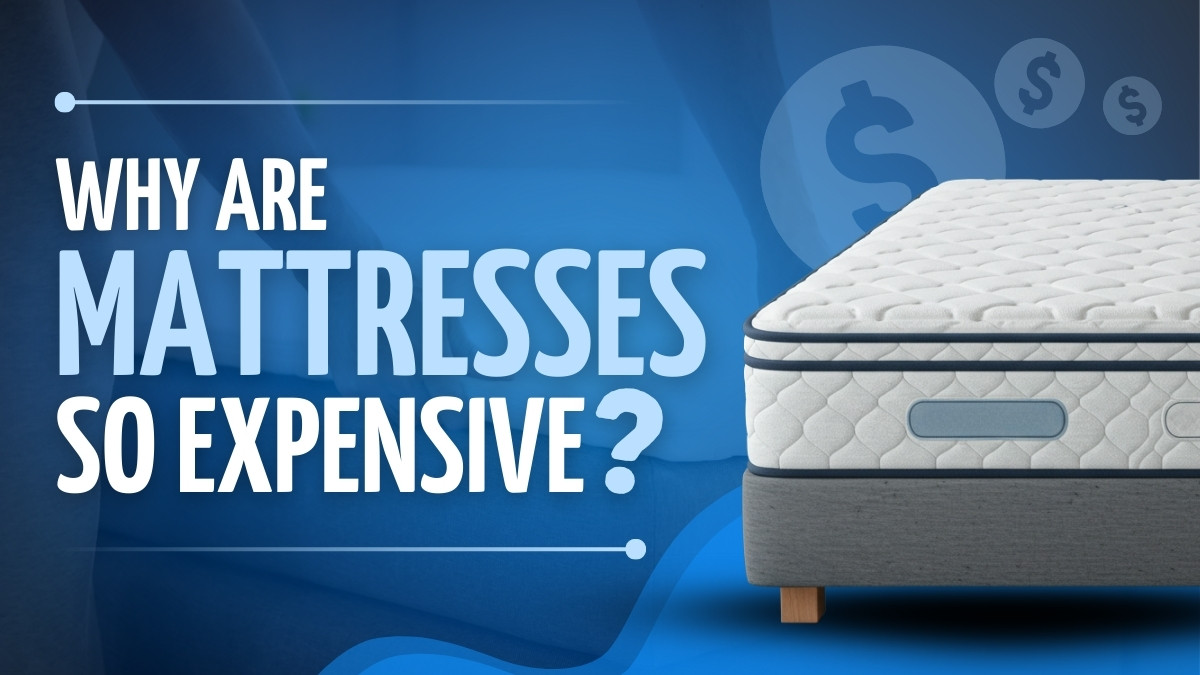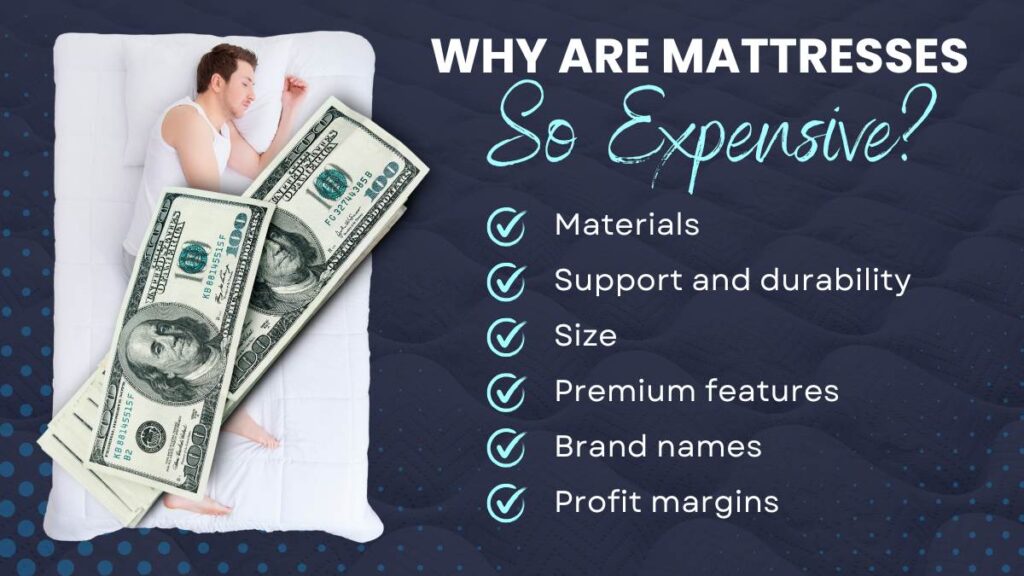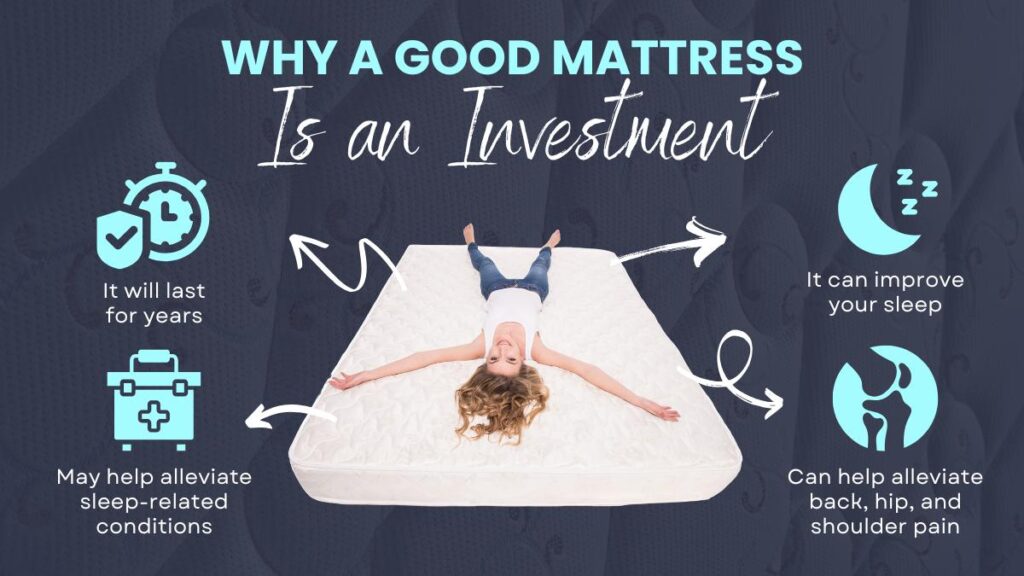
Why do mattresses cost so much?
Everybody moans when they have to buy one, but are mattresses overpriced, or are they cheaper than you think if you employ certain cost-saving tricks?
Let’s explore the world of mattresses and see if what you’re getting warrants a large upfront investment and what you need to do to cut costs.
Why Are Mattresses So Expensive?
A mattress doesn’t look like much, but a good one is made from expensive materials that require large factories and skilled workers.
If you’re wondering, “Are expensive mattresses worth it?” or “Why are some mattresses so expensive?” let’s examine what’s involved in making them and what you get in return.

Materials
One factor driving up the retail cost of a mattress is the materials used. Luxury mattresses use scientifically engineered memory foam and steel coils, as well as imported ingredients and natural materials like organic latex, cotton, and wool.
Many mattresses are also made to be hygienically sound and free of harmful toxins and allergens. However, most of these features are usually absent in cheap mattresses or those with very low price tags.
Support and Durability
If you’ve ever woken up with a backache after sleeping on a bad mattress, you know how much you’ll pay all day by suffering from discomfort and low energy.
In comparison, the support and pressure relief a good mattress provides after a long day is well worth it. Plus, with so many mattress companies now offering lifetime warranties, you’ll be guaranteed that the mattress you buy will serve you a long time.
Size
The larger a mattress is the higher the price range. But if you sleep with a partner, then figuring out your initial investment in terms of a two-income household makes the cost per day even lower than the average life span of a quality mattress.
Premium Features
Are luxury mattresses worth it? Some of the elements and features of a premium mattress that address the question include:
- Naturally sourced and highly quality materials are used in their construction.
- Advanced orthopedic structure and support systems that allow you the most space and comfort.
- Extra features like pillow tops, cooling gels, zoned firmness, and flippable models offer different sleep landscapes.
- Certifications that let you know the mattress you’re buying has been verified by a knowledgeable third party.
- White glove delivery service for people with difficulty moving heavy items or simply want a seamless and stress-free experience.
Brand Names
Like any other product, a brand name’s reputation associated with excellence and customer satisfaction justifies why mattresses are so expensive.
Manufacturers like Milton Sleep Co., DreamCloud, and PlushBeds have earned their reputations by offering a wide variety of mattresses to suit different sleep styles and preferences and excellent customer service.
Marketing and Advertising
It costs money to make a mattress, advertise it, and sell it to the most people. Maintaining showrooms or brick-and-mortar stores, distributing products to retail outlets, advertising in media, and having an online store all reflect the high cost of mattresses.
Profit Margins
The mattress industry will earn over 87 billion dollars by 2033 [1]. This is because its profit margins are currently between 40% and 50%. That means a mattress that may cost $600-700 to manufacture and distribute will sell for over $1,000.
The Secondhand Market Is Small
If a mattress is clean and in good condition, you can sell it depending on the regulations of the state where you reside. Generally, used mattresses sell for 20-30% of their original value [2].
That’s why, after cleaning costs and marketing, selling used mattresses is not very lucrative for retail outlets or manufacturers.
Tips to Help You Save Money on Your Next Mattress
Now that we’ve answered the question of why mattresses cost so much from a manufacturer’s perspective, let’s look at ways to solve the problem of dealing with costly mattresses.
Do Your Research Before Hitting the Market
It is important for consumers to be aware of what’s available before spending their hard-earned money. How expensive are mattresses you’re interested in, both online and in stores? Who has the best mattress prices for what you want?
Set a Budget
You should also set a budget, but be willing to expand on it if you find something that is really what you want and need. Also, be open to exploring different payment options that might allow you to increase your budget if you’re paying over time and not making one huge payment.
Look Out for Special Sales
With the current markup rates on mattresses, sellers still profit even if they give you 10-20% off. As a result, sales are just an easier way for retailers to move mattresses. But when are mattresses typically on sale? We recommend keeping your eyes peeled for holidays and at the change of seasons.
Consider Buying Mattress and Bedding Bundles
There are several advantages to purchasing mattress and bedding bundles:
- Buying a mattress with matching products can be more cost-effective than buying separately.
- You can save on delivery charges if you order multiple things simultaneously.
- Buying bedding bundles from the same manufacturer ensures everything will fit together perfectly.
- You can also get a blanket warranty if you buy multiple products from the same manufacturer.
Choose a Low APR If Financing Your Purchase
If you constantly wonder, “Why are mattresses so expensive?” and deny yourself one, consider taking out a low annual percentage rate loan (APR). This can substantially lower your interest over the time you’ll be paying off your purchase, and the mattress will become less of a financial burden over time.
Eliminating a high interest rate will make it easier to keep up with payments and help you maintain a good credit rating.
Shopping Online Can Save You More
Besides being more convenient, shopping online usually offers more sales, and many online stores routinely offer free shipping, longer trial periods, and free setup services.
Why a Good Mattress Is an Investment
While a good mattress might require a more significant upfront cost, it’s a long-term investment that pays dividends in the following ways:

It Will Last for Years
The average life span of a modern mattress is approximately 7-10 years, depending on the make and model you buy. Plus, many of the top mattress companies offer lifetime warranties. That means if your mattress deteriorates due to normal wear and tear, you can get it replaced for as little as a delivery fee.
It Can Help Alleviate Back, Hip, and Shoulder Pain
If you’re not sleeping well on your current mattress and especially have issues such as back, hip, or shoulder pain, consider investing in a new mattress.
Compared to the cost of ongoing orthopedic or chiropractic care and even surgery, the cost of an ergonomically sound mattress is a wise investment. Studies show that a medium-firm mattress is ideal for back issues. If you want to sleep comfortably, get good quality sleep, and keep your spine healthy, a medium-firm mattress is the way to go.
It May Help Alleviate Sleep Apnea and Restless Leg Syndrome
Sleep apnea is a disorder that causes people to sometimes stop breathing regularly while they are asleep, and restless leg syndrome is when people feel an irresistible urge to move their legs due to a tingling or pulling sensation.
A comfortable, well-aligned mattress can significantly help with both of these conditions by providing proper support and pressure point relief for the hips, shoulders, neck, and spine.
It Can Improve Your Sleep Quality
If you worry about why mattresses are so expensive and it makes you afraid to invest in a good one, consider some ways that a suitable mattress can give you a good night’s sleep:
- A good quality mattress helps you maintain proper spinal alignment
- Good quality mattresses also help to relieve the pressure points at your shoulders and spin
- If you’re prone to waking up sweaty, a cooling mattress can help regulate your body temperature.
How Much Does a Mattress Cost?
Several factors, such as size, type, materials, quality, brand, and the technology used, determine the cost of a mattress.
For example, a queen-size mattress can cost from $300 to more than $3,000, depending on whether it’s an innerspring, foam, or hybrid model. A luxury king-size mattress or memory foam mattress from brands like Saatva or Purple can cost $1,500 – $4,000.
How Long Can a Mattress Last?
The average life span of a foam mattress is 7-10 years. 15-20 years is the typical lifespan of high-quality latex mattresses, far exceeding the average lifespan of innerspring or even memory foam mattresses. However, this estimate can be affected by an individual’s mattress size and sleeping habits, as well as how many people are sleeping on the mattress in question.
How to Help Your Mattress Last Longer
By following these tips, you can significantly extend the life of your mattress, ensuring years of comfortable and restful sleep.
Rotate or Flip Your Mattress Regularly
It is usual for a mattress to start sagging over time. One way to combat that is to either flip or rotate it. Flipping is mostly for older innerspring mattresses and should be done every 3 to 6 months.
That literally means you turn the mattress over and sleep on the other side so that any sags can fall back out over time. Rotating accomplishes the same end, except it’s for modern foam or hybrid mattresses where you can only sleep on one side.
Add a Mattress Protector or Topper
A removable mattress topper can provide added padding and protect the surface of your mattress from dirt, dust mites, and bacteria that can build up over time.
Clean Your Mattress Regularly
Sprinkling baking soda over your mattress periodically can help deodorize it. You should also launder your bed linens regularly to remove sweat, body oils, and allergens that can accumulate over time.
Expert Insights
Mattresses command a high price for a multitude of reasons, starting with the quality of materials. Jackson Lindeke, a mattress expert and certified sleep science coach at Sleep Foundation, explained that higher-quality materials like natural latex, organic cotton, and individually wrapped coils contribute to a more comfortable and supportive sleep experience, but also come at a higher cost [3].
Beyond materials and construction, factors like brand reputation, marketing costs, and retail markups play a significant role in the final price tag. Online reviews often reflect this price sensitivity, with users on platforms like Reddit frequently citing cost as a major consideration when choosing a mattress.
In a thread on r/sleep, while some Redditors appreciate the long-term investment in a good night’s sleep, others express frustration with the high cost, especially for those on a tight budget [4].
Ultimately, the price of a mattress reflects a complex interplay of material costs, manufacturing processes, brand value, and consumer demand.
FAQs
The following are some questions asked by curious customers exploring the cost of mattresses.
Why Do Mattresses Cost So Much Money?
The high cost of latex, memory foam, organic cotton and wool toppers, and support systems like pocketed coils all contribute to a mattress’s high cost. On the sales end, the high markup on mattresses done by retailers also inflates the cost of the average mattress.
What Is a Reasonable Price to Pay for a Mattress?
Depending on the brand, materials, and construction, most people can find a quality mattress for approximately $500 – $1,500.
Is It Worth Paying for a Good Mattress?
Yes, paying for a good mattress can be worth it because of the long-term health benefits of healthy sleep stages and patterns.
What Is the Markup on Mattresses?
The average markup on name-brand mattresses is usually between 40-50%, which is why they are so expensive.
Do Mattresses Really Make a Difference?
Yes, a mattress can significantly affect the quality of your sleep and, thus, your overall health by keeping you well-rested and your body in proper alignment.
How Often Does the Average Person Buy a Mattress?
According to many sleep experts, it is recommended to replace your mattress every 7-10 years.
Why Is Purple Mattress So Expensive?
Purple mattresses are known for their unique Hyper-Elastic Polymer™ grid, a proprietary material that sets them apart in the mattress world. However, they are generally more affordable than luxury brands like Saatva or Tempur-Pedic.
What Are the Most Expensive Mattresses?
The Hästens Vividus, handcrafted with meticulous detail using premium natural materials like horsetail hair, wool, and flax, takes the crown with a price tag exceeding $400,000. Another contender is the Vispring Diamond Majesty, boasting exquisite craftsmanship and opulent materials like Shetland wool, silk, and cashmere, with a price tag ranging from $80,000 to over $150,000.
Conclusion: Why Are Mattresses So Expensive?
In these times of inflation, everything is expensive, including mattresses. Since experts advise changing your mattress every 7-10 years, the cost breakdown for a luxury mattress can be less than $200 per year.
Think of the things you spend more than that on and ask yourself, are those things more important than my health?
With APR financing, lifetime warranties, and sales, maybe thinking of mattresses as expensive items that you don’t need is a mindset you’re ready to outgrow.
 11 Niche Experts
11 Niche Experts
 100+ Product Reviews
100+ Product Reviews
 50+ Tested Products
50+ Tested Products
At BestDaily, our mission is simple: to help you make confident, informed decisions about the products that impact your daily life. Whether you're searching for wellness essentials or lifestyle upgrades, we combine hands-on testing with expert analysis to highlight what truly works.

